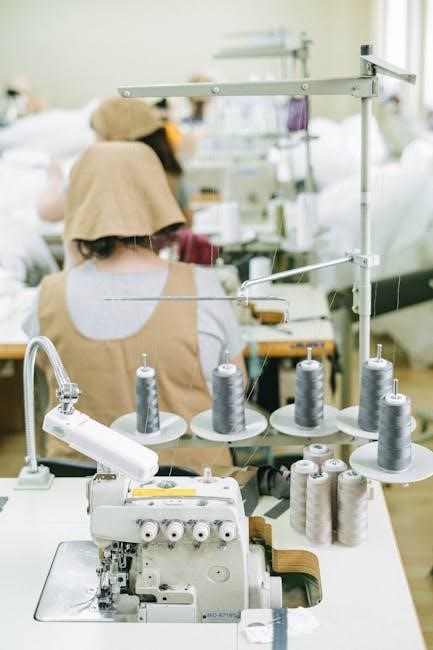
Learning to use a thread guide is essential for sewing machine operation, utilizing various components to control thread flow, ensuring smooth stitches and preventing issues, with proper techniques and tips, via online resources.
Importance of Thread Guide
The thread guide plays a crucial role in the overall performance of a sewing machine, as it helps to regulate the flow of thread and maintain consistent tension. Proper use of the thread guide is essential for achieving smooth and even stitches, and for preventing common issues such as tangled threads and uneven tension. By understanding the importance of the thread guide, sewers can improve the quality of their work and reduce the risk of errors. The thread guide is a critical component of the sewing machine, and its proper use is vital for achieving professional-looking results. With the help of online resources and sewing machine manuals, sewers can learn how to use the thread guide effectively and take their sewing skills to the next level. Effective use of the thread guide can also help to extend the life of the sewing machine and reduce the need for repairs.
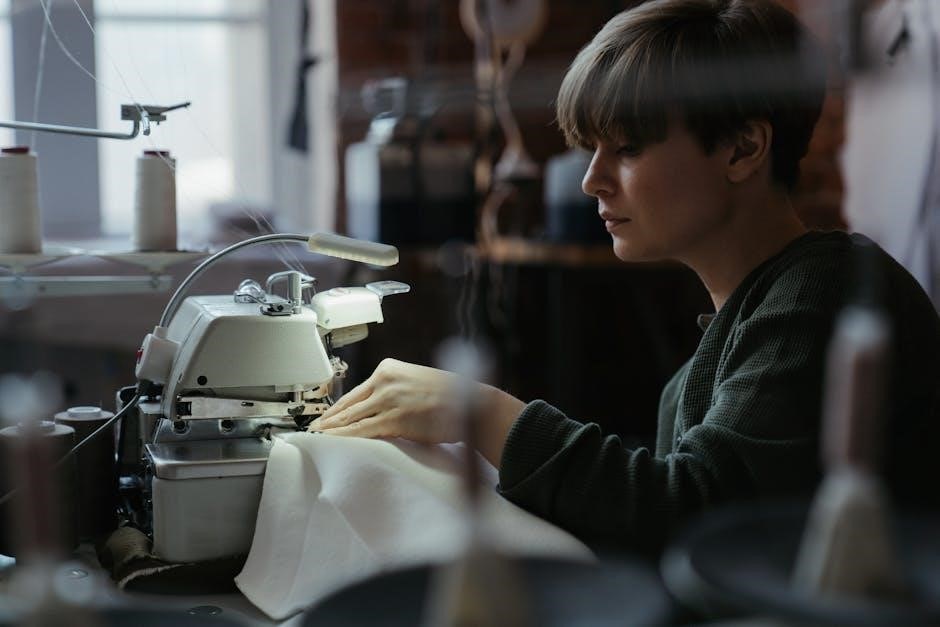
Step-by-Step Threading Process
Threading a sewing machine involves several steps, using guides and following a specific sequence to ensure proper thread flow and tension, for successful sewing operations always.
Threading Down Front of Sewing Machine
To thread down the front of the sewing machine, bring the thread through guide number 3, which is typically a vertical groove located on the front of the machine, and then proceed to the next step in the threading process. This step is crucial as it helps to establish the correct thread path and tension, utilizing the machine’s built-in thread guides and take-up levers to control the thread flow. By following the manufacturer’s instructions and using the correct threading technique, users can ensure that their sewing machine is properly threaded and ready for use. The threading process should be done carefully and patiently to avoid any mistakes or tangles, and to achieve the best possible sewing results, with a smooth and even stitch quality, and the correct thread tension, which is essential for a professional-looking finish, and a successful sewing project, with the help of online resources and tutorials.
Threading Back Up the Sewing Machine
Threading back up the sewing machine involves bringing the thread under and around guide 4 and up to the top of the machine, where it will lay in a specific path, utilizing the machine’s thread guides and take-up levers to control the thread flow and tension. This step is critical in establishing the correct thread path and ensuring that the thread is properly seated in the machine, with the help of online tutorials and resources. The thread should be wrapped around the take-up lever and guided through the needle’s eye, using a needle threader if necessary, to ensure that the thread is properly seated and ready for sewing. By following the manufacturer’s instructions and using the correct threading technique, users can ensure that their sewing machine is properly threaded and ready for use, with a smooth and even stitch quality, and the correct thread tension, which is essential for a professional-looking finish, and a successful sewing project, with the help of online resources and tutorials, and a thorough understanding of the threading process.
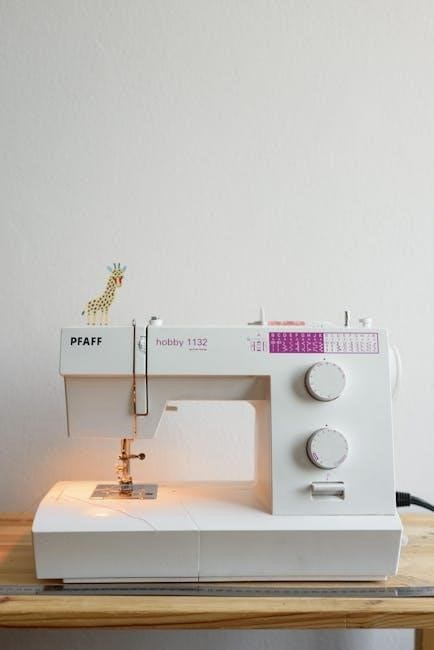
Components of Thread Guide System
Thread guide system includes pre-tensioners, take-up levers, and needle guides, via online resources, for smooth operation, with proper techniques, and tips, for a sewing machine, using various components.
Pre-Tensioners and Their Function
Pre-tensioners play a crucial role in the thread guide system of a sewing machine, regulating thread tension before it reaches the needle. They ensure that the thread is not too loose or too tight, which can affect the quality of the stitch. According to online resources, pre-tensioners are designed to provide a consistent tension, allowing for smooth and even stitching. The pre-tensioner’s function is to regulate the thread’s tension, preventing issues such as tangled threads or uneven tension. By controlling the thread’s tension, pre-tensioners enable sewers to achieve professional-looking results. With proper use of pre-tensioners, sewers can enjoy a more efficient and productive sewing experience. Pre-tensioners are an essential component of the thread guide system, and understanding their function is vital for optimal sewing machine performance. They work in conjunction with other components, such as take-up levers and needle guides, to ensure a seamless sewing experience.
Take-Up Levers and Their Role
Take-up levers are a vital component of the thread guide system in sewing machines, responsible for lifting the thread after each stitch. They play a crucial role in maintaining the thread’s tension and ensuring a smooth stitching process. According to online resources, take-up levers work by pulling the thread up and away from the needle, allowing for a consistent flow of thread. This helps to prevent issues such as thread breakage or uneven tension. The take-up lever’s role is to regulate the thread’s movement, enabling sewers to achieve a professional finish. By understanding how to properly use the take-up lever, sewers can improve their sewing experience and achieve better results. Take-up levers are designed to work in conjunction with other thread guide components, such as pre-tensioners and needle guides, to provide a seamless sewing experience. They are an essential part of the sewing machine’s mechanism, and their proper function is crucial for optimal performance.
Needle Guides and Their Purpose
Needle guides are small components located just above the needle in a sewing machine, playing a crucial role in guiding the thread through the needle’s eye. Their purpose is to ensure that the thread is properly seated and aligned with the needle, allowing for smooth and consistent stitching. According to online resources, needle guides come in different types and designs, depending on the sewing machine model and type of needle being used. They are typically small metal or plastic pieces that are attached to the sewing machine’s needle bar or presser foot. The needle guide’s purpose is to prevent thread tangling and breakage, while also helping to maintain even thread tension. By guiding the thread through the needle’s eye, needle guides enable sewers to achieve professional-looking stitches and prevent common sewing problems. Properly functioning needle guides are essential for optimal sewing machine performance and are a critical component of the thread guide system.
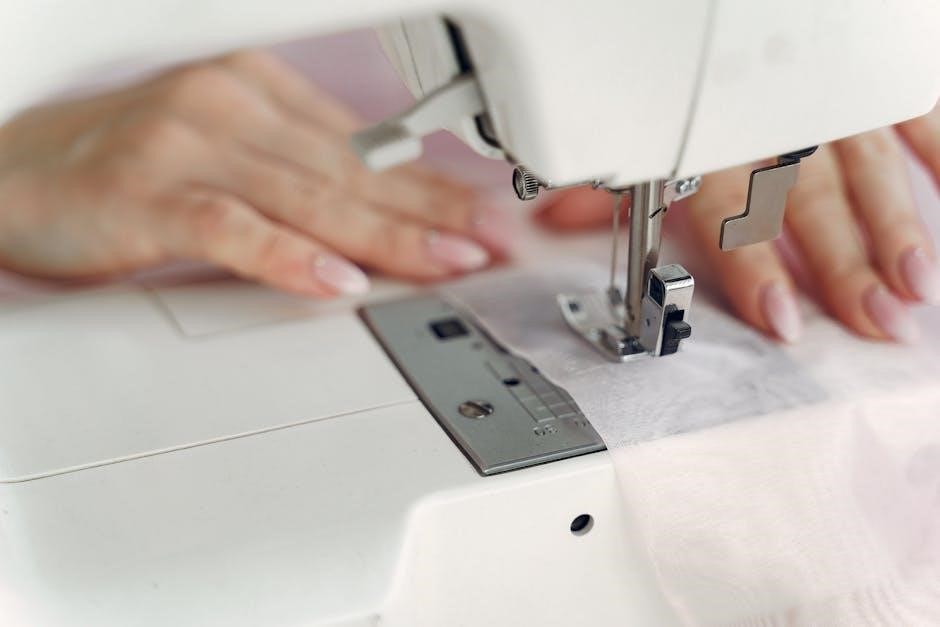
Threading Techniques and Tips
Mastering threading techniques via online tutorials and guides enhances sewing machine operation, ensuring efficient and smooth stitching, with proper thread flow, using various methods and tools, every time, perfectly.
Using Needle Threaders and Guides
Needle threaders and guides are essential tools for threading a sewing machine, making the process easier and more efficient. These tools help to navigate the thread through the machine’s complex system, ensuring that it is properly seated and ready for use. By utilizing a needle threader, users can avoid the frustration of trying to thread the needle by hand, which can be time-consuming and tedious. The guide provides a clear path for the thread to follow, reducing the risk of tangles and knots. Many sewing machines come equipped with built-in needle threaders and guides, while others may require the purchase of separate accessories. Regardless of the type, these tools are invaluable for anyone looking to streamline their sewing process and achieve professional-looking results. With the help of needle threaders and guides, users can focus on creating beautiful and intricate stitches, rather than struggling with the threading process. This allows for a more enjoyable and productive sewing experience.
Managing Thread Tension and Flow
Proper thread tension and flow are crucial for achieving smooth and consistent stitches. The thread guide plays a significant role in managing tension, as it helps to regulate the flow of thread through the machine. By adjusting the thread guide, users can control the amount of tension applied to the thread, ensuring that it is not too tight or too loose. This is especially important for delicate or thick fabrics, which can be damaged by excessive tension. Additionally, the thread guide helps to prevent thread breakage and tangling, which can be caused by uneven tension. To manage thread tension and flow, users can refer to their sewing machine manual for guidance on adjusting the thread guide and tension discs; By following these guidelines, users can achieve optimal thread tension and flow, resulting in professional-looking stitches and a more enjoyable sewing experience. This requires some practice and patience to get it just right.
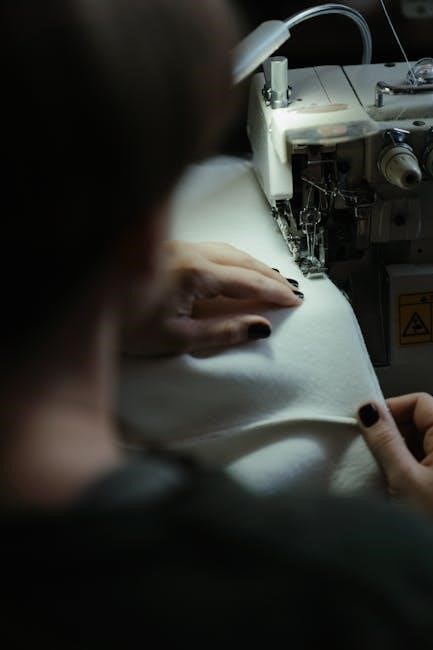
and Best Practices
To conclude, mastering the thread guide in a sewing machine is essential for achieving professional-looking stitches and a smooth sewing experience. By following best practices, such as regularly cleaning and maintaining the machine, users can ensure optimal performance and prevent common issues. It is also important to refer to the sewing machine manual for specific guidance on threading and thread tension. Additionally, practicing threading and sewing with different types of fabric and thread can help users develop their skills and become more confident. By combining these best practices with patience and attention to detail, users can unlock the full potential of their sewing machine and create high-quality garments and textiles. Furthermore, staying up-to-date with the latest sewing machine models and technologies can also help users to improve their skills and stay ahead of the curve. This can be achieved by attending sewing classes or workshops, or by joining online sewing communities.